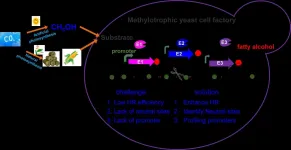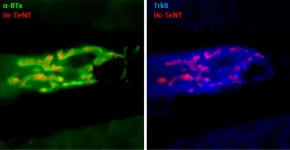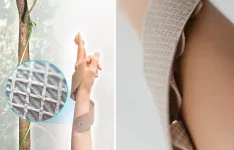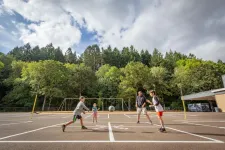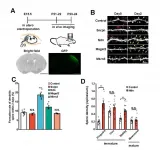The giant panda's mystery revealed
The evolution of the temporomandibular joint and premolar teeth enabled adaptation to bamboo diet
2021-07-09
(Press-News.org) Although the giant panda is in practice a herbivore, its masticatory system functions differently from the other herbivores. Through the processes of natural selection, the giant panda's dietary preference has strongly impacted the evolution of its teeth and jaws. Researchers from the Institute of Dentistry at the University of Turku and the Biodiversity unit of the University of Turku together with researchers from the China Conservation and Research Center for Giant Panda (CCRCGP) have been the first in the world to solve the mystery of how the giant panda's special stomatognathic system functions.
The bamboo diet of the giant panda (Ailuropoda melanoleuca) has long been a mystery for researchers. The panda is in practice a herbivore, and its diet only consists of few dozen species of bamboo. Related to the consumption of bamboo, the giant panda has a special characteristic of peeling the green outer skin of all bamboo shoots, rich in abrasive and toxic compounds, by the highly adapted premolars.
Herbivores have usually evolved to have ridged molars that help them grind the plant material and jaws capable of moving sideways which is essential for grinding their food. Although the teeth of giant pandas have been studied extensively, until now, researchers have not paid attention to why the large canines of their upper jaw do not prevent the sideways movement of the lower jaw typical for herbivores - and also humans. The key to this has been the evolution of the temporomandibular joint and the premolar teeth.
Evolution of the Temporomandibular Joint Allows Sideways Movement
Using modern 3D scanning methods, the research group studied the movement of the giant panda's jaw and the structure of its teeth and found the answer to the question that had puzzled researchers for over a century: how are giant pandas able to use bamboo as their diet. The solution was that the panda's temporomandibular joint has evolved to differ from that of e.g. brown bear and polar bear. In addition to the open-closed movement reminding that of a hinge, the joint also allows the jaw to be moved sideways, which is required to peel the bamboo. Interestingly, this movement isn't prevented by the large canines the male pandas need to fight.
- The necessity to ensure adequate nutrition has helped evolve the temporomandibular joint and the shape of the teeth to allow efficient peeling of the bamboo without without exposing the premolars to the attritive or other damaging effect of bamboo diet, explains Professor Pekka Vallittu from the Institute of Dentistry.
The evolution of the giant panda's masticatory system, as demonstrated in the study, allowed them to be the only large mammals to access an endless source of nutrition in the form of bamboo in the early Pleistocene.
- The premolars giant pandas use for peeling bamboo are unique among the family of bears and allow the removal of the poisonous green skin of the bamboo which also includes mineral crystals which would wear their teeth, says Professor Juha Varrela from the Institute of Dentistry.
The study of how the giant panda's masticatory system functions also helps to understand human's occlusion and its characteristics better.
- Whether giant pandas grind their teeth still remains to be seen, ruminates Vallittu.
- This newly published study is of great scientific significance because it solves the long-prevailing mystery of the ecological interrelationship between the pandas and the bamboo plants, says Professor Jukka Salo from the Biodiversity Unit of the University of Turku.
INFORMATION:
Salo has been an active participant in the panda project of the Finnish Ähtäri Zoo and the study of the panda habitat in the Qionglai Mountains in the Sichuan province of China. Professor of Environmental Sciences and Biodiversity Pekka Niemelä from the University of Turku has also studied pandas in the area for a long time. The University of Turku has lead four conservation projects in the panda habitat of Sichuan together with the State Forestry and Grassland Administration (SFGA) of China and the CCRCGP in 1998-2008. Two pandas were able to be transferred to Finland as the outcome of this collaboration, and the CCRCGP also participated in this project and will be participating in up-coming projects, too.
The research article was published in the international journal Scientific Reports: http://www.nature.com/articles/s41598-021-93808-2
[Attachments] See images for this press release:

ELSE PRESS RELEASES FROM THIS DATE:
2021-07-09
Pichia pastoris (syn. Komagataella phaffii), a model methylotrophic yeast, can easily achieve high density fermentation, and thus is considered as a promising chassis cell for efficient methanol biotransformation. However, inefficient gene editing and lack of synthetic biology tools hinder its metabolic engineering toward industrial application.
Recently, a research group led by Prof. ZHOU Yongjin from the Dalian Institute of Chemical Physics (DICP) of the Chinese Academy of Sciences established an efficient genetic engineering platform in Pichia pastoris.
The study was published in Nucleic Acids Research on July 1.
The researchers developed ...
2021-07-09
Depression has been treated traditionally with inhibitors of serotonin reuptake in the central nervous system. These drugs do not come without side effects, such as lack of immediate therapeutic action, the need for daily doses and the danger of becoming addicted to some of these drugs. That is why scientists continue to work on new therapies to treat depression.
In 2019, an international group of researchers co-led by Dr Yousef Tizabe from the Howard University College of Medicine in Washington, D.C., and Professor José Aguilera from the Department of Biochemistry and Molecular Biology and the Institut de Neurociències ...
2021-07-09
To splice or not to splice...
In an article published in the journal RNA, Karan Bedi, a bioinformatician in Mats Ljungman's lab, Department of Radiation Oncology at the University of Michigan Medical School, investigated the efficiency of splicing across different human cell types. The results were surprising in that the splicing process appears to be quite inefficient, leaving most intronic sequences untouched as the transcripts are being synthesized. The study also reports variable patterns between the different introns within a gene and across cell lines, and it further highlights ...
2021-07-09
Researchers at the University of Freiburg and the University of Stuttgart have developed a new process for producing movable, self-adjusting materials systems with standard 3D-printers. These systems can undergo complex shape changes, contracting and expanding under the influence of moisture in a pre-programmed manner. The scientists modeled their development based on the movement mechanisms of the climbing plant known as the air potato (Dioscorea bulbifera). With their new method, the team has produced its first prototype: a forearm brace that adapts to the wearer and which can be further developed for medical applications. ...
2021-07-09
Recess quality, not just the amount of time spent away from the classroom, plays a major role in whether children experience the full physical, mental and social-emotional benefits of recess, a new study from Oregon State University found.
"Not all recess is created equal," said William Massey, study author and an assistant professor in OSU's College of Public Health and Human Sciences. With schools returning to full-time in-person classes this fall, he said, "Now is a good time to rethink, 'How do we create schools that are more child-friendly?' I think ensuring quality access to play time and space during the school day is a way we can do that." ...
2021-07-09
A research group including Kobe University's Professor TAKUMI Toru (also a Senior Visiting Scientist at RIKEN Center for Biosystems Dynamics Research) and Assistant Professor TAMADA Kota, both of the Physiology Division in the Graduate School of Medicine, has revealed a causal gene (Necdin, NDN) in autism model mice that have the chromosomal abnormality (*1) called copy number variation (*2).
The researchers hope to illuminate the NDN gene's molecular mechanism in order to contribute towards the creation of new treatment strategies for developmental disorders including autism.
These research results were published in Nature Communications on July 1, 2021.
Main Points
The research ...
2021-07-09
Although Covid-19 affects men and women differently, the large majority of current clinical studies of SARS-CoV-2 and COVID-19 makes no mention of sex/gender. Indeed, only a fraction, 4 percent, explicitly plan to address sex and gender in their analysis, concludes a new analysis of nearly 4,500 studies. 21 percent only take this variable into account when selecting participants while 5.4 % go as far as planning to have sex-matched or representative subgroups and samples. The article is published in Nature Communications.
During the corona pandemic, differences can be observed between men and women. Men are more vulnerable to a severe course of COVID-19; ...
2021-07-09
Tokyo, Japan - Scientists from The University of Tokyo Institute of Industrial Science have designed a machine learning algorithm to predict the size of an individual cell as it grows and divides. By using an artificial neural network that does not impose the assumptions commonly employed in biology, the computer was able to make more complex and accurate forecasts than previously possible. This work may help advance the field of quantitative biology as well as improve the industrial production of medications or fermented products.
As in all of the natural sciences, biology has developed mathematical models to help fit data and make predictions about the future. However, because of the inherent complexities of living ...
2021-07-09
Split liver transplantation (SLT) provides an opportunity to divide a donor liver and offer transplants to two small patients, one or both of whom could be a child. SLT, which is underused in the United States, could be used more widely to decrease the number of deaths of people on transplant waiting lists. In a new article, researchers address some of the ethical decisions that go into decisions to split a liver and provide a model to help hospitals make SLT decisions.
The article, by researchers at Carnegie Mellon University (CMU), appears in The BMJ, which is published by the Institute of Medical Ethics.
"Should a large liver always be split if it is medically safe to do so?" asks Sridhar Tayur, Professor of Operations ...
2021-07-09
Tsukuba, Japan - A scientist from the Division of Quantum Condensed Matter Physics at the University of Tsukuba has formulated a new theory of superconductivity. Based on the calculation of the "Berry connection," this model helps explain new experimental results better than the current theory. The work may allow future electrical grids to send energy without losses.
Superconductors are fascinating materials that may look unremarkable at ambient conditions, but when cooled to very low temperatures, allow electrical current to flow with zero resistance. There are several obvious applications of superconductivity, such as lossless energy ...
LAST 30 PRESS RELEASES:
[Press-News.org] The giant panda's mystery revealed
The evolution of the temporomandibular joint and premolar teeth enabled adaptation to bamboo diet

